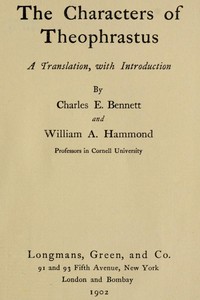The Characters of Theophrastus by Theophrastus
"The Characters of Theophrastus" by Theophrastus is a collection of character sketches written in ancient Greece during the late 4th century BC. This work is often recognized as one of the earliest studies of human character types, describing various moral and social defects observed in individuals of his time. Theophrastus, a pupil of Aristotle, provides a unique window into both the personalities prevalent in Athenian society and the timeless qualities of human
nature that are still relevant today. The book consists of thirty brief but incisive portraits, each highlighting a different flawed character, from "The Flatterer" to "The Coward," and "The Boor" to "The Avaricious Man." Theophrastus employs a straightforward and vivid style to showcase these character types, often emphasizing their behaviors in everyday situations. Instead of delving into complex narratives or moral judgments, he illustrates how these archetypes manifest in society and interact with others. Consequently, these sketches serve not only as observations but also as a reflection of the human condition, showcasing the absurdities and follies that people continue to exhibit in all cultures and eras. (This is an automatically generated summary.)
Read or download for free
| How to read | Url | Size | |||
|---|---|---|---|---|---|
| Read now! | https://www.gutenberg.org/ebooks/58242.html.images | 139 kB | |||
| EPUB3 (E-readers incl. Send-to-Kindle) | https://www.gutenberg.org/ebooks/58242.epub3.images | 105 kB | |||
| EPUB (older E-readers) | https://www.gutenberg.org/ebooks/58242.epub.images | 105 kB | |||
| Kindle | https://www.gutenberg.org/ebooks/58242.kf8.images | 178 kB | |||
| older Kindles | https://www.gutenberg.org/ebooks/58242.kindle.images | 144 kB | |||
| Plain Text UTF-8 | https://www.gutenberg.org/ebooks/58242.txt.utf-8 | 107 kB | |||
| Download HTML (zip) | https://www.gutenberg.org/cache/epub/58242/pg58242-h.zip | 89 kB | |||
| There may be more files related to this item. | |||||
Similar Books
About this eBook
| Author | Theophrastus, 370? BCE-286? BCE |
|---|---|
| Translator | Bennett, Charles E. (Charles Edwin), 1858-1921 |
| Translator | Hammond, William A. (William Alexander), 1861-1938 |
| LoC No. | 02026885 |
| Title |
The Characters of Theophrastus A Translation, with Introduction |
| Note | Reading ease score: 65.8 (8th & 9th grade). Neither easy nor difficult to read. |
| Contents | Introduction -- Epistle dedicatory -- The dissembler (I.) -- The flatterer (II.) -- The coward (XXV.) -- The over-zealous man (IV.) -- The tactless man (XII.) -- The shameless man (IX.) -- The newsmonger (VIII.) -- The mean man (X.) -- The stupid man (XIV.) -- The surly man (XV.) -- The superstitious man (XVI.) -- The thankless man (XVII.) -- The suspicious man (XVIII.) -- The disagreeable man (XX.) -- The exquisite (XXI.) -- The garrulous man (III.) -- The bore (VII.) -- The rough (VI.) -- The affable man (V.) -- The impudent man (XI.) -- The gross man (XIX.) -- The boor (IV.) -- The penurious man (XXII.) -- The pompous man (XXIV.) -- The braggart (XXIII.) -- The oligarch (XXVI.) -- The backbiter (XXVIII.) -- The avaricious man (XXX.) -- The late learner (XXVII.) -- The vicious man (XXIX.) |
| Credits | E-text prepared by Turgut Dincer and the Online Distributed Proofreading Team (http://www.pgdp.net) from page images generously made available by Internet Archive (https://archive.org) |
| Language | English |
| LoC Class | PA: Language and Literatures: Classical Languages and Literature |
| Subject | Character sketches -- Early works to 1800 |
| Category | Text |
| EBook-No. | 58242 |
| Release Date | Nov 6, 2018 |
| Most Recently Updated | Jun 15, 2020 |
| Copyright Status | Public domain in the USA. |
| Downloads | 366 downloads in the last 30 days. |
| Project Gutenberg eBooks are always free! | |

